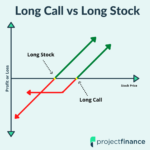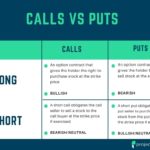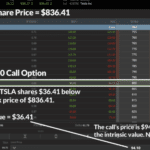Last updated on February 10th, 2022 , 02:19 pm
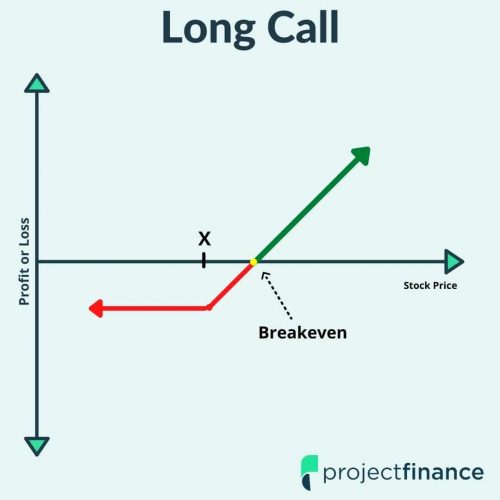
Long Call Option Characteristics
A long call option (when a trader buys a call option) is a bullish strategy that profits when the stock price increases quickly and significantly. Buying call options is the most aggressive way to trade a bullish stock price outlook.
In this guide, you’re going to learn everything you need to know about buying calls, and you’ll also see examples of when the strategy profits and loses money.
·Maximum Profit Potential: Unlimited
·Maximum Loss Potential: Premium Paid for the Call
·Expiration Breakeven Price: Call Strike + Premium Paid for Call
·Estimated Probability of Profit: Less Than 50%
·Assignment Risk?
Since the call owner has full control of exercising, there is no assignment risk. However, a call buyer should pay attention to the stock price near expiration. If the call expires in-the-money, the trader will end up with 100 shares of stock per call contract.
To better understand these metrics as they relate to buying call options, let’s go over a simple example.
If you’d prefer to watch the video, check it out below!
Jump To
Long Call Profit & Loss Potential at Expiration
In the following example, we’ll construct a long call position from the following option chain:
In this case, let’s assume the stock price is trading for $100 and we purchase the 100 call:
Stock Price: $100
Call Strike Price: $100
Premium Paid for Call: $5
If a trader buys this call option, their potential profits and losses at expiration are described by the following chart:
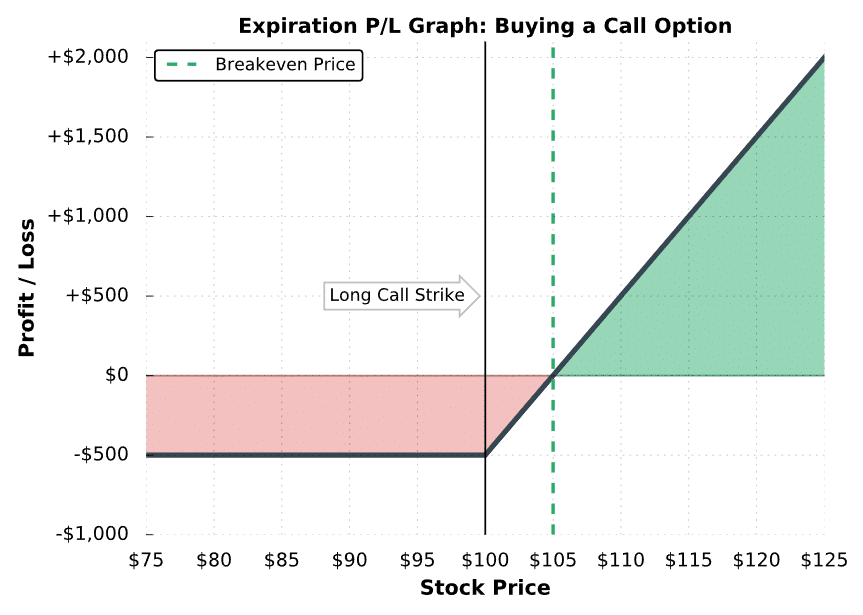
Long Call Max Loss
In this scenario, the maximum loss is the premium the trader pays, which is $5 ($500 in actual dollar terms since one option contract represents 100 shares of stock). The maximum loss occurs when the stock price is below the strike price at expiration because the call will expire worthless. A call option has no value at expiration if the stock price is not above the call’s strike price.
Long Call Max Profit
Additionally, since a stock’s price has no upper limit, the potential profit for the call buyer is unlimited. However, with limited loss potential and unlimited profit potential, buying call options is a low probability strategy. This should make sense, as the stock price must increase more than 5% for any profits to be made at expiration (though profits can still be made before expiration if the stock price increases quickly).
So you know the outcomes for a long call position at expiration, but what happens before the option expires? Before expiration, understanding how profits and losses occur when buying call options can be explained by the strategy’s option Greeks (if you want to better understand the risks of your options positions, read our ultimate guides on the option Greeks).
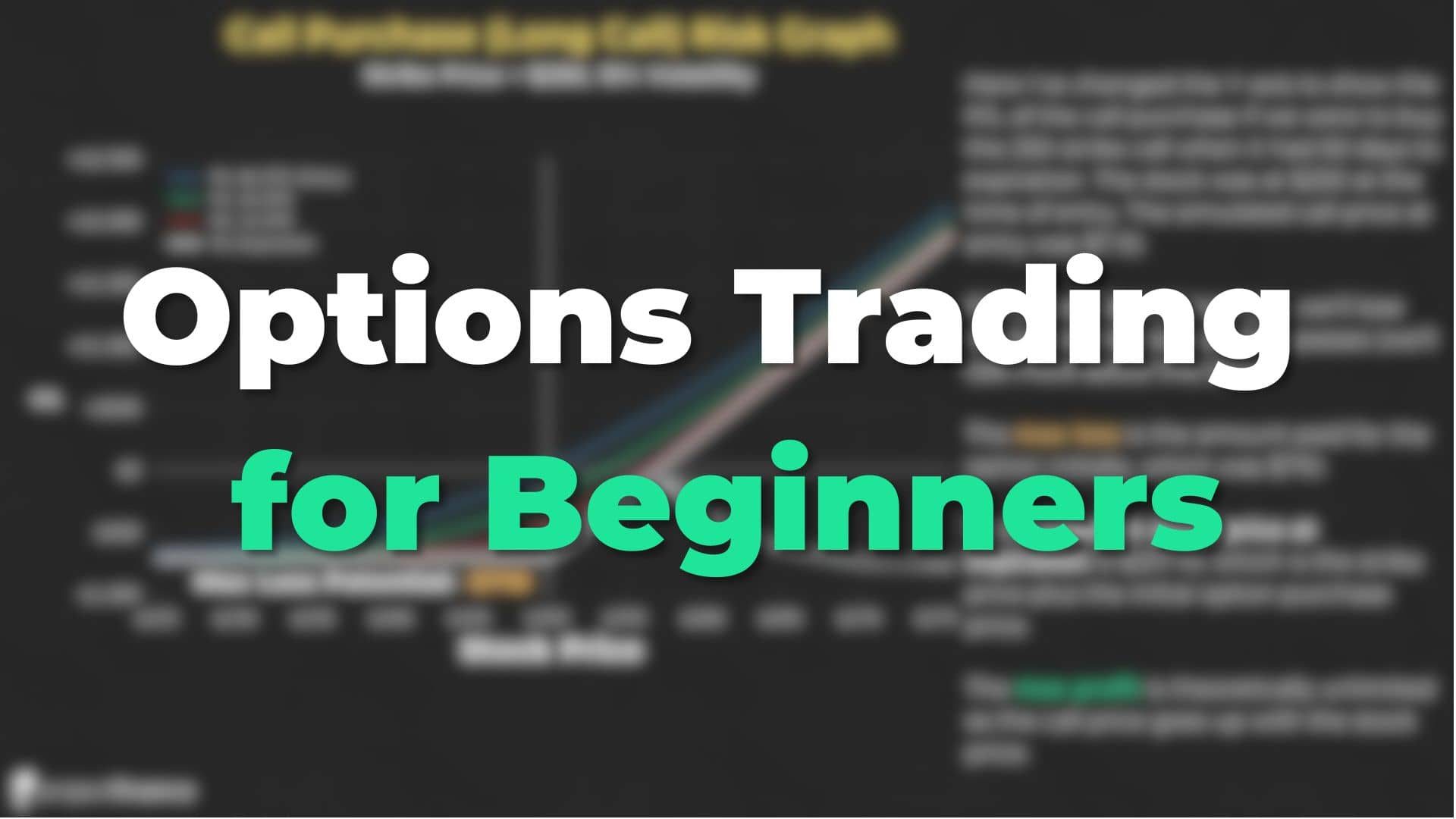
New to options trading? Learn the essential concepts of options trading with our FREE 160+ page Options Trading for Beginners PDF.
Option Greek Exposures When Buying Calls
The following describes the option Greek exposures for a long call position:
Positive Delta – Call prices rise when the stock price increases, which benefits the call buyer. Conversely, call prices fall when the stock price decreases, which is not good for the call buyer.
Positive Gamma – A long call’s position delta gets closer to +100 as the stock price increases and closer to 0 as the stock price decreases.
Negative Theta – The extrinsic value of options decays as time passes, which is detrimental to a call buyer.
Positive Vega – Increases in implied volatility indicate an increase in option prices, which is beneficial to the call buyer. On the other hand, decreases in implied volatility indicate a decrease in option prices, which is harmful to a call owner.
When buying call options, a trader’s worst nightmare is the passage of time. To be profitable when buying calls, the stock price or implied volatility must increase to offset the losses from theta decay.
To understand this further, let’s look at some examples of call option trades.
Long Call Trade Examples
To visualize the performance of buying call options, let’s look at a few examples.
Trade Example #1: Call Option vs. Time Decay
The first example we’ll look at is a situation where a trader buys an at-the-money call option (strike price near the stock price). Here are the specifics:
Initial Stock Price: $105
Initial Implied Volatility: 30%
Call Strike and Expiration: 105 call expiring in 31 days
Call Purchase Price:$3.40
Call Breakeven Price: $105 call strike price + $3.40 debit paid for call = $108.40
Maximum Profit Potential: Unlimited
Maximum Loss Potential: $3.40 call purchase price x 100 = $340
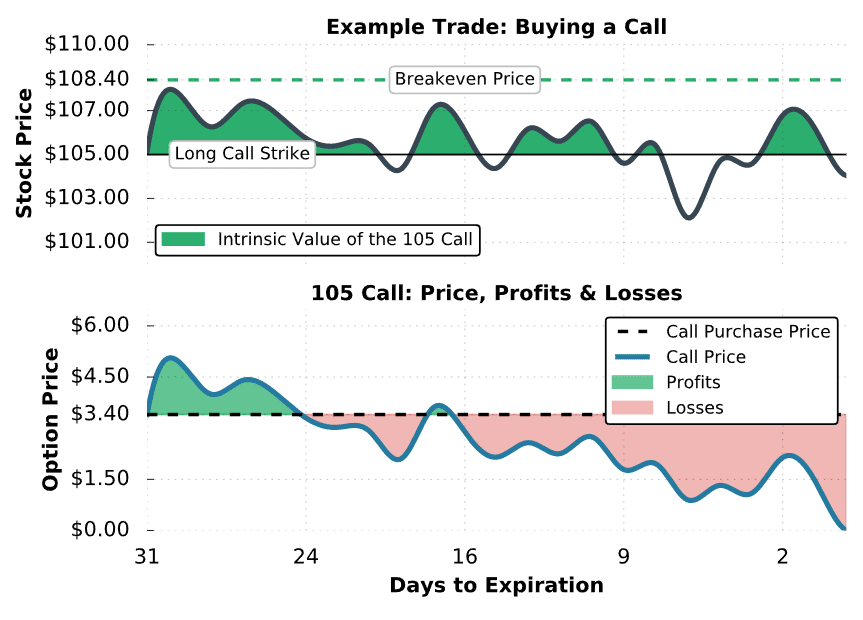
Trade #1 Results
As we can see, the stock price never traded higher than the call’s breakeven price. At the same time, the stock price also never crashed significantly below the call’s strike price. As a result, the call option experienced a slow decay, leading to losses for the call buyer. In this specific example, the main drivers of the position’s losses were the passage of time (time/theta decay) and the stock price moving in the wrong direction (positive delta strategy but the stock price decreased).
However, there were still opportunities for the call trader to close the position for profits early in the trade. To close a long call position before expiration, a trader can simply sell the call option at its current price. As an example, if the trader sold the call when it was worth $4.50, they would have locked in $110 in profits: ($4.50 sale price – $3.40 initial purchase price) x 100 = +$110.
Trade Example #2: Call Option vs. Decreasing Stock Price
In this next example, we’ll look at a situation where a trader buys an in-the-money call option (strike price below the stock price). Traders buy in-the-money call options to increase the amount of directional exposure they have (as in-the-money calls have deltas closer to +1). Additionally, since the option’s price is mostly intrinsic, the effects of theta decay are minimal.
Here are the specifics:
Initial Stock Price: $201.02
Initial Implied Volatility: 21%
Call Strike and Expiration: 190 call expiring in 46 days
Initial Call Delta:+0.75
Call Purchase Price:$13.38
Call Breakeven Price: $190 call strike price + $13.38 debit paid for call = $203.38
Maximum Profit Potential: Unlimited
Maximum Loss Potential: $13.38 call purchase price x 100 = $1,338
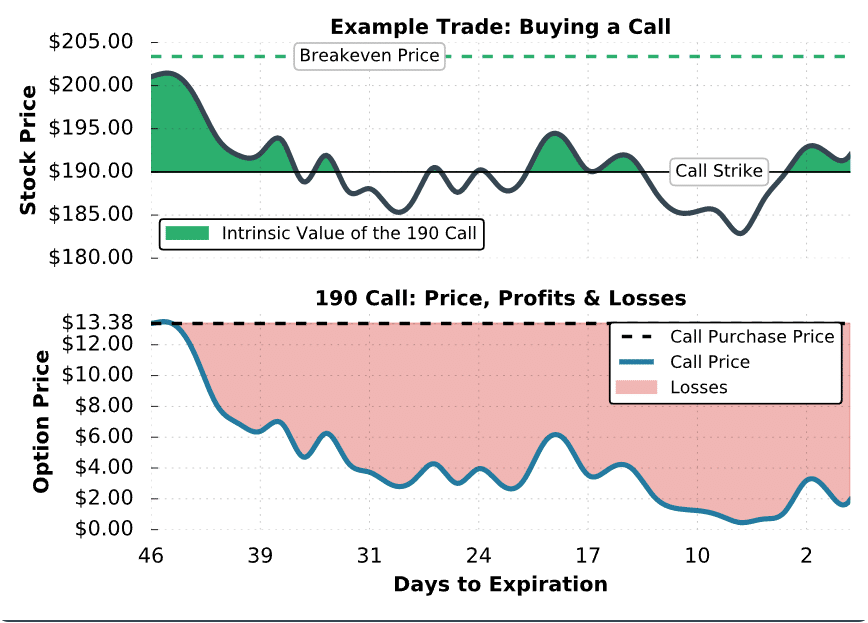
Trade #2 Results
With an initial delta of +0.75, the 190 call option was expected to lose $0.75 for each $1 decrease in the stock price, which explains why the position performed so poorly when the stock price fell from $201 to $185. Over the same period, implied volatility increased from 21% to 28%. Unfortunately, that wasn’t enough to offset the losses from the decrease in the stock price.
From a probabilistic perspective, the decline in the call option’s price makes sense. With the stock price at $200, the probability of the 190 call expiring in-the-money was approximately 75% (based on a delta of 0.75). However, as the stock price fell to $185, the 190 call’s price fell because the likelihood of expiring in-the-money diminished.
As mentioned previously, a call option can always be closed before expiration. As an example, let’s say the trader in this example wanted to cut their losses when the call traded down to $10. If the trader sold the call for $10, they would have locked in losses of $338: ($10 sale price – $13.38 purchase price) x 100 = -$338.
At expiration, the stock was trading around $192, and the 190 call was worth its intrinsic value of $2.00. With an initial purchase price of $13.38, the resulting loss is $1,138 per contract for the call buyer. If the trader held the call through expiration, the resulting position would be +100 shares of stock per contract. The effective purchase price of these shares would be $203.38, which is the call’s strike price of $190 plus the $13.38 purchase price of the option.
Alright, you’ve seen what can go wrong when buying calls. Let’s finish by investigating what needs to happen to profit when buying call options.
Trade Example #3: Profitable Call Purchase
So, what exactly needs to happen to profit from a long call position? As discussed earlier, the stock price needs to rise to offset losses from time decay. To demonstrate this, we’ll look at a situation where a trader buys an at-the-money call before the stock price rises significantly.
Here are the specifics of the next example:
Initial Stock Price: $94.02
Initial Implied Volatility: 31%
Strike and Expiration: 92.5 call expiring in 42 days
Call Purchase Price:$4.65
Call Breakeven Price: $92.5 call strike price + $4.65 call purchase price = $97.15
Maximum Profit Potential: Unlimited
Maximum Loss Potential: $4.65 call purchase price x 100 = $465
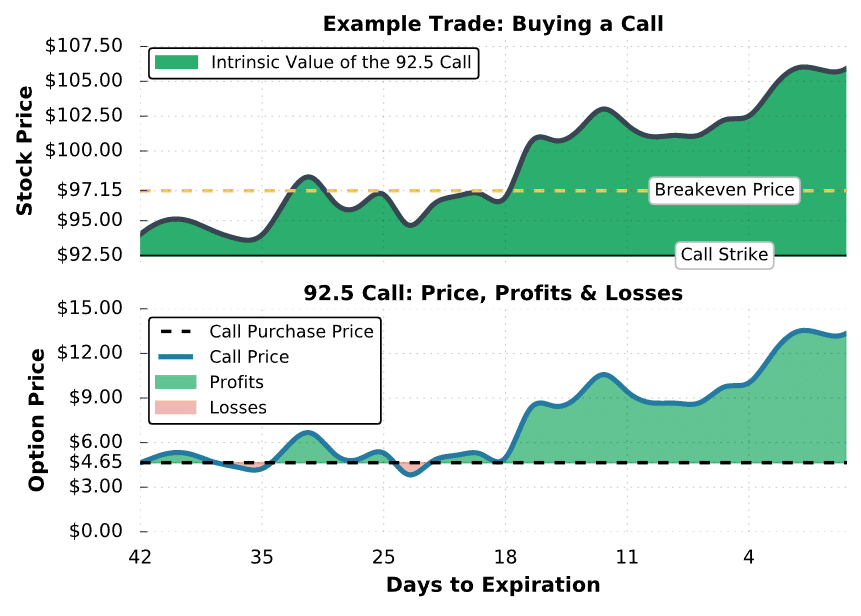
Trade #3 Results
The first important note about this visual is that the stock price rose from $94 to around $97 in the first 24 days. However, the position still wasn’t very profitable because the increase wasn’t fast enough to offset losses from time decay.
Luckily, at around 18 days to expiration, the stock price rises more than 5% in the following week. Consequently, the 92.5 call buyer experienced healthy profits. At the time of expiration, the stock was trading for $105.85, and the call was worth its intrinsic value of $13.35. With an initial purchase price of $4.65, the resulting profit in this case was $870 per contract for the call buyer.
In this example, buying a call option was a home run trade. However, such a position requires the timing of an unexpectedly large move in the correct direction, which is very unlikely.
Final Word
Congratulations! You’ve reached the end of the guide. By now, you should have a pretty good understanding of how buying calls works and what needs to happen to make money when doing so.
projectfinance Options Tutorials

About the Author
Chris Butler received his Bachelor’s degree in Finance from DePaul University and has nine years of experience in the financial markets.
Chris started the projectfinance YouTube channel in 2016, which has accumulated over 25 million views from investors globally.

New to options trading? Learn the essential concepts of options trading with our FREE 160+ page Options Trading for Beginners PDF.

